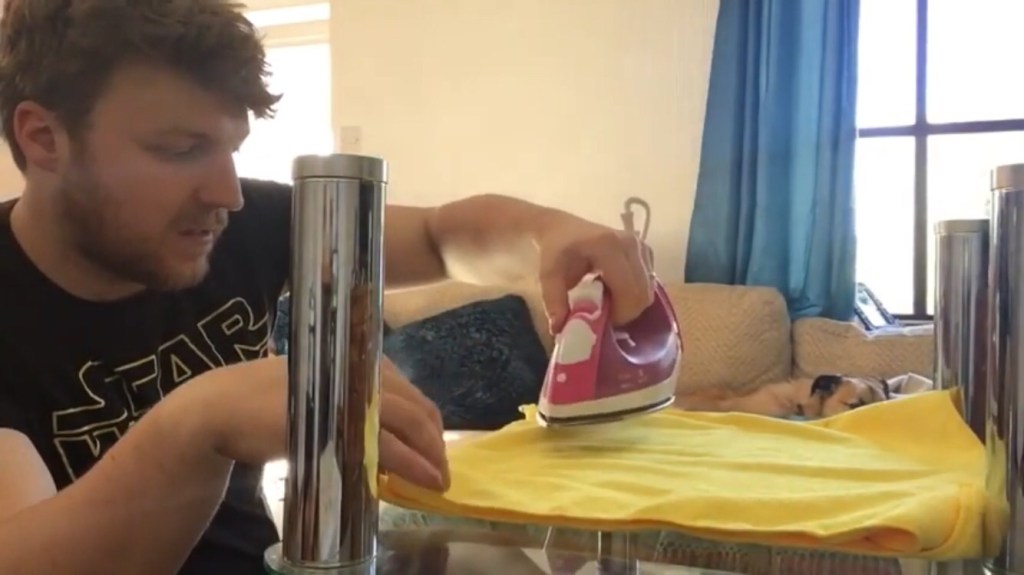
Picture the scene. You find a rare record you really like, which is inexplicably low-priced and as yet undiscovered.
And then you find out why.
It’s warped.
One of the most difficult problems in the record collecting world to fix. Yuri Geller had it right. Far easier to bend things than to straighten them. It would have been far more a) impressive and b) useful had he turned his all-powerful mind to the issue of warped vinyl, but I guess there are some things that outstretch even the greatest heroes of our age.
Sure, YouTube is full of earnest young men putting old records found in flea markets between a couple of sheets of glass and putting them in an oven for ten minutes at gas mark 1, but as anyone who has ever baked a cake or watched The Great British Bake Off will know, every oven is different, there’s a combination of heat, moisture and the burnt embers of last Sunday’s roast dinner and, well, it all feels a bit unscientific. If all I had at stake was an old copy of Cliff’s “I’m No Hero” album I’d probably make a video too, but I’m not sure I would trust my oven with anything more valuable than a nice tarte tatin.
If you do have a particularly treasured but warped LP you want to fix, you want odds a little more certain than those of you baking a perfectly risen Victoria sponge at a first attempt.
I did enjoy this YouTuber’s attempt at using an iron to flatten his LPs mind you, with tongue, I am sure, firmly in the side of his cheek.
The other method you hear about is taking the record, inserting it between sheets of glass, and then exposing it to the sun in a warm room.
Again, you don’t need to have sat in a car on a hot day to know how quickly those temperatures rise, and how uncontrollable this all is.
The risk anyone takes using these methods is if the heat necessary to flatten the vinyl goes on to damage the grooves. Apply too little heat, the warp remains. Apply too much and you mush the grooves and ruin the sound.
The answer here is not to start up your own Heston Blumenthal-style vinyl chemistry lab. All you need is a tennis racquet, a postage stamp, two bits of card, a record mailer, some bubble wrap and a biro.
First, chuck away the tennis racquet. I put that in there to throw you off the scent.
The answer is actually to use a “professional” record flattener.
Yes, this does exist.
It’s called an Orb DF-01IA High-End (in case there was any doubt) audio vinyl LP (to not confuse it with all the visual vinyl LPs out there) Record Flattener.
It’s basically a posh trouser press for records.
It weighs 17kg and costs £1,219.99.
To be fair, that does include VAT.

It is purchased by the sort of people who think nothing of spending £1,295 on a cartridge and £795 on a pre-amp.

According the press release, it is “essential”, which should alert the compilers of the Oxford English Dictionary as a new meaning for the word “essential”.
Perhaps it falls into the same “essential” category as Waitrose “Essential” Tonic Water. Nothing more “essential” than a gin and tonic, eh?

But there is some science here. Rather than rushing in to an uncontrolled, random level of heat generated by something that just cooked a stew, the process is slow: it takes four hours; two to heat up and two to cool down.
What’s more, the grooves are protected. The machine heats only the outer edge and centre of the record. The grooves are untouched, and this reduces potential damage.
But….the price!
I know what you’re thinking. And that’s disgraceful language. You should wash your mouth out with soap.
But don’t worry. Help is at hand.
The answer is to use the gig economy. To outsource.
Because there are people out there who have one, and having fixed their warped records, they are realising having an expensive bit of kit out there is a bit of a folly. It’s like having Lionel Messi in your team of football players, and leaving him on the bench.
So, I put it to the test. I approached a “record flattening service” with one of these machines. You can find these services on eBay and through analogueseduction.net.
Five years ago I bought a copy of Tom Petty’s Wildflowers album for an eye-watering fifty pounds. I did so, because it was impossible to find a copy for less than £100 and it’s one of my favourite records. “Essential”, if you like.
Although £50 was as much as I had ever paid for a record, I thought I had a bargain.
When I got it home I realised why it had been priced that way. One of the LPs was warped. Here’s a “before” video of the warp. It played, but that’s quite a “leap”.
The LP now regularly averages £170 on Discogs. Flattening it cost £8. If it worked, it was a no-brainer.
I’m pleased to say the £1,200 machine worked. Here’s how it looks now…
In conclusion, there is no easy, safe way to rectify a warped record without being able to methodically control temperatures and where the heat is applied, as our iron-wielding YouTuber has demonstrated. But with the help of a bit of outsourcing, those of us who don’t have £1,200 knocking around can fix a record or two…
Good luck! (And please share your tales of vinyl flattening – successful and unsuccessful in the comments section).
Was this post helpful? Every Record Tells A Story: A Vinyl Handbook is out now, packed full of vinyl-related advice and the stories behind great records. You can buy the book by clicking this link to the online store


Leave a reply to 2loud2oldmusic Cancel reply